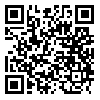Volume 21, Issue 3 (9-2022)
TB 2022, 21(3): 66-79 |
Back to browse issues page
Download citation:
BibTeX | RIS | EndNote | Medlars | ProCite | Reference Manager | RefWorks
Send citation to:



BibTeX | RIS | EndNote | Medlars | ProCite | Reference Manager | RefWorks
Send citation to:
soltani T, Mazloomy Mahmoodabad S S, Nadjarzadeh A, Fallahzadeh H, Soltani M H, vaezi A A et al . Analysis of the salt consumption situation using SWOT approach and providing solutions related to COMBI strategies. TB 2022; 21 (3) :66-79
URL: http://tbj.ssu.ac.ir/article-1-3273-en.html
URL: http://tbj.ssu.ac.ir/article-1-3273-en.html
Tahere Soltani 

 , Seyed Saeed Mazloomy Mahmoodabad *
, Seyed Saeed Mazloomy Mahmoodabad * 

 , Azadeh Nadjarzadeh
, Azadeh Nadjarzadeh 

 , Hossein Fallahzadeh
, Hossein Fallahzadeh 

 , Mohammad Hossein Soltani
, Mohammad Hossein Soltani 

 , Ali Akbar Vaezi
, Ali Akbar Vaezi 

 , Seyedeh Mahdyeh Namayandeh
, Seyedeh Mahdyeh Namayandeh 




 , Seyed Saeed Mazloomy Mahmoodabad *
, Seyed Saeed Mazloomy Mahmoodabad * 

 , Azadeh Nadjarzadeh
, Azadeh Nadjarzadeh 

 , Hossein Fallahzadeh
, Hossein Fallahzadeh 

 , Mohammad Hossein Soltani
, Mohammad Hossein Soltani 

 , Ali Akbar Vaezi
, Ali Akbar Vaezi 

 , Seyedeh Mahdyeh Namayandeh
, Seyedeh Mahdyeh Namayandeh 


School of Public Health, Shahid Sadoughi University of Medical Sciences, Yazd, Iran. , mazloomy.mm@gmail.com
Abstract: (883 Views)
Introduction: excessive consumption of salt is one of the unhealthy eating habits and is one of the factors in the high prevalence of cardiovascular diseases and the resulting mortality. Using swot tool is one of the effective measures in understanding the society, planning and new solutions for behavior modification. So, the aim of this study was to investigate the factors related to salt consumption in the target society in order to provide solutions to improve the current situation.
Methods: An exploratory study was conducted in hamidia town of yazd city in 2020. Qualitative data were collected using three focus groups and twenty four individual interviews with women and eleven individual interviews with health workers. Quantitative data of knowledge, attitude and performance of women regarding salt consumption were collected using a validated questionnaire regarding salt consumption through a 4-part researcher. The amount of salt consumed was measured through a 24-hour food questionnaire and a urine test. Themes were identified from quantitative and qualitative data and analyzed and were interpreted using a swot matrix and solutions were designed using strategies COMBI.
Results: the results of research showed that the highest priority among the strengths, weaknesses, opportunities and threats of the program are, respectively, trusting the training of doctors and center personnel with the importance coefficient of 0.06, insufficient awareness about the complications of excessive salt consumption with the importance coefficient 0.06, the presence of nutrition experts in health centers and access to health professionals with the importance coefficient of 0.05 and the existence of conflicting information in the society about salt consumption with the importance coefficient of 0.053.
Conclusion:
Our results showed that, the best strategy for the program of reducing salt consumption in the target society was an aggressive strategy. Therefore, the relevant officials can, implement the aggressive strategies presented in this research to reduce the salt consumption
Methods: An exploratory study was conducted in hamidia town of yazd city in 2020. Qualitative data were collected using three focus groups and twenty four individual interviews with women and eleven individual interviews with health workers. Quantitative data of knowledge, attitude and performance of women regarding salt consumption were collected using a validated questionnaire regarding salt consumption through a 4-part researcher. The amount of salt consumed was measured through a 24-hour food questionnaire and a urine test. Themes were identified from quantitative and qualitative data and analyzed and were interpreted using a swot matrix and solutions were designed using strategies COMBI.
Results: the results of research showed that the highest priority among the strengths, weaknesses, opportunities and threats of the program are, respectively, trusting the training of doctors and center personnel with the importance coefficient of 0.06, insufficient awareness about the complications of excessive salt consumption with the importance coefficient 0.06, the presence of nutrition experts in health centers and access to health professionals with the importance coefficient of 0.05 and the existence of conflicting information in the society about salt consumption with the importance coefficient of 0.053.
Conclusion:
Our results showed that, the best strategy for the program of reducing salt consumption in the target society was an aggressive strategy. Therefore, the relevant officials can, implement the aggressive strategies presented in this research to reduce the salt consumption
Type of Study: Research |
Subject:
Special
Received: 2021/10/6 | Accepted: 2022/06/21 | Published: 2022/09/1
Received: 2021/10/6 | Accepted: 2022/06/21 | Published: 2022/09/1
Send email to the article author
| Rights and permissions | |
 |
This work is licensed under a Creative Commons Attribution-NonCommercial 4.0 International License. |




